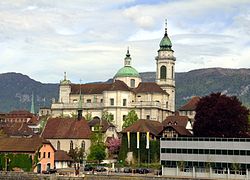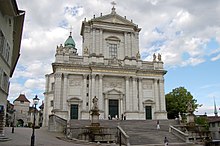
Solothurn is a town, a municipality, and the capital of the canton of Solothurn in Switzerland. It is located in the north-west of Switzerland on the banks of the Aare and on the foot of the Weissenstein Jura mountains.

St. Hedwig's Cathedral is the Catholic cathedral of the Archdiocese of Berlin on Bebelplatz in the historic centre of Berlin. Dedicated to Hedwig of Silesia, it was erected from 1747 to 1887 by order of Frederick the Great according to plans by Georg Wenzeslaus von Knobelsdorff in Baroque style. Damaged during the Allied bombing in World War II, the cathedral's interior was restored from 1952 to 1963 in post-war modernist style as part of the rebuilding of the Forum Fridericianum on Bebelplatz. Since 2018, the listed building has been closed for renovation, and is expected to reopen in the Fall of 2024.

St. Stephen's Cathedral is a Roman Catholic church in Vienna, Austria, and the mother church of the Archdiocese of Vienna. It is the seat of the Archbishop of Vienna, Christoph Schönborn.
Johannes Aal was a Swiss Roman Catholic theologian, composer and dramaturg.

Bern Minster is a Swiss Reformed cathedral in the old city of Bern, Switzerland. Built in the Gothic style, its construction started in 1421. Its tower, with a height of 100.6 m (330 ft), was only completed in 1893. It is the tallest cathedral in Switzerland and is a Cultural Property of National Significance.
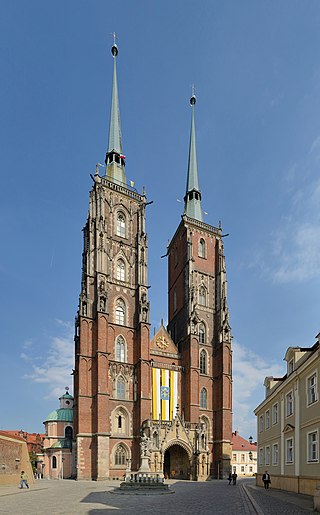
The St. John the Baptist Archcathedral is the seat of the Archdiocese of Wrocław and a landmark of the city of Wrocław in Poland. The cathedral, located in the Cathedral Island, is a Gothic church with Neo-Gothic additions. The current standing cathedral is the fourth church to have been built on the site.
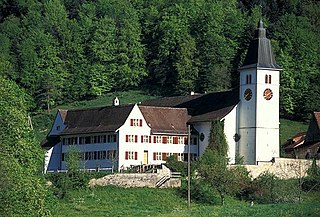
Beinwil Abbey was a Benedictine monastery in Beinwil in the Canton of Solothurn in Switzerland.

The St. George Cathedral, colloquially known as the Roman Catholic Dome, is the cathedral of the Roman Catholic Diocese of Timișoara and one of the city's landmarks. The cathedral is dedicated to St. George and was built between 1736 and 1774. After the Cathedral Basilica of Oradea, it is the second largest Baroque religious building in Southeastern Europe. Liturgies in Hungarian, German and Romanian are currently held regularly in the cathedral. Due to the remarkable acoustics, organ concerts are also held here.

Ursus of Solothurn was a 3rd-century Roman Christian venerated as a saint. He was associated very early with the Theban Legion and is recorded in the Roman Martyrology, with Victor of Solothurn on 30 September.

Basel Minster is a religious building in the Swiss city of Basel, originally a Catholic cathedral and today a Reformed Protestant church.
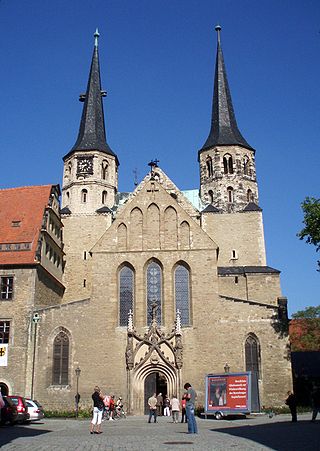
Merseburg Cathedral is the proto-cathedral of the former Bishopric of Merseburg in Merseburg, Germany. The mostly Gothic church is considered an artistic and historical highlight in southern Saxony-Anhalt.

Essen Minster, since 1958 also Essen Cathedral is the seat of the Roman Catholic Bishop of Essen, the "Diocese of the Ruhr", founded in 1958. The church, dedicated to Saints Cosmas and Damian and the Blessed Virgin Mary, stands on the Burgplatz in the centre of the city of Essen, Germany.

Würzburg Cathedral is a Roman Catholic cathedral in Würzburg in Bavaria, Germany, dedicated to Saint Kilian. It is the seat of the Bishop of Würzburg and has served as the burial place for the Prince-Bishops of Würzburg for hundreds of years. With an overall length of 103 metres, it is the fourth largest Romanesque church building in Germany, and a masterpiece of German architecture from the Salian period. Notable later additions include work by Tilman Riemenschneider and Balthasar Neumann. The cathedral was heavily damaged by British bombs in March 1945 but rebuilt post-World War II.

Gottstat Monastery is a former Premonstratensian monastery in the municipality of Orpund in the Canton of Bern, Switzerland.

Köniz Castle is a castle in the municipality of Köniz of the Canton of Bern in Switzerland. It is a Swiss heritage site of national significance.

Chur Cathedral, otherwise known as the Cathedral of the Assumption of Mary, is the Catholic cathedral of the diocese of Chur in Switzerland. The episcopal palace of the bishop of Chur is beside the church. The cathedral claims the relics of St Lucius of Britain, said to have been martyred nearby in the late 2nd century. During the Swiss Reformation, the Catholic population of the city were confined to a ghetto enclosed around the bishop's court beside the cathedral. It is a Swiss heritage site of national significance.

Münster is one of the two main churches of the old town of the Swiss city of Schaffhausen. First built in 1064 AD as a Romanesque Basilica of the then Benedictine Kloster Allerheiligen, it was rebuilt several times, and became in 1524 the Reformed Church of the city of Schaffhausen.

The Solothurn Madonna is an oil-on-panel painting created in 1522 by the German-Swiss artist Hans Holbein the Younger in Basel. The painting depicts the Virgin Mary and Christ enthroned, flanked by Martin of Tours, shown as a bishop giving alms to a beggar, and Ursus of Solothurn, depicted as a soldier in armour. Notably, Holbein used his wife, Elsbeth, as the model for the Madonna, and the baby is believed to have been modelled after Holbein and Elsbeth's infant son Philipp.
The Boys' Choir of St Ursus Cathedral in Solothurn are a Swiss boys' choir from Solothurn. The tradition of the choir is based on the medieval Schola of St. Ursenstift, the collegiate church that preceded Solothurn Cathedral, and which is first mentioned in 742. This makes the choir the oldest boys' choir in Switzerland. The choir is denominationally neutral today. The repertoire includes both religious and secular choral literature from all eras.

Andreas Reize is a Swiss organist and conductor, with a focus on opera and choral conducting. He was appointed Thomaskantor on 11 September 2021, becoming the 18th director of music to take charge of the world famous Thomanerchor at Leipzig in succession to Johann Sebastian Bach.
